Just like Silicon Valley operates as a technology incubator in the business world, there are some parts of the country that seem to breed world-class marching ensembles. These groups not only co-exist in a friendly manner, but they also drive each other to be the best in their class.
 The Chino Hills, California, area is home to three percussion ensembles that compete on the world stage. Ayala High School’s concert percussion and marching percussion ensembles have won a combined nine WGI Sport of the Arts championships, including this year’s Scholastic World Class in both Concert and Marching categories.
The Chino Hills, California, area is home to three percussion ensembles that compete on the world stage. Ayala High School’s concert percussion and marching percussion ensembles have won a combined nine WGI Sport of the Arts championships, including this year’s Scholastic World Class in both Concert and Marching categories.
The Chino Hills High School percussion ensemble, a formidable contender and three-time WGI Scholastic World Class champion, placed second this year. Another neighbor, Chino High School, has been a WGI World Class finalist.
The Chino Valley Unified School District—with all three of these high schools—has cornered the market in indoor percussion.
Ike Jackson, the director of the Ayala Percussion Ensemble, says that the success these groups enjoy starts in junior high. “We were able to create a junior high program, and that program was … the only one that I’m aware of that has gone to the world championship and has made finals in the A class,” Jackson says.
The Chino Hills region is not alone in its development of marching programs. Other regions, cities, and school districts including those in Indianapolis, Atlanta, parts of Texas, and elsewhere seem to incubate stellar bands. As these powerhouses blossom, they set the bar for their competition and become exemplars for what other programs can become.
More Marching Incubators
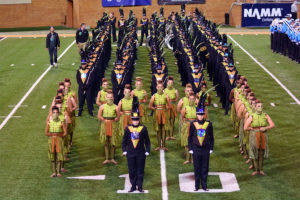 Clear across the nation in Fort Mill, South Carolina, the Fort Mill High School Band and the Nation Ford High School Band have a combined 29 state championships and several Bands of America (BOA) Regional championships. Fort Mill won its first state championship in the 1970s. Since its establishment in 2007, Nation Ford has contributed five state championships and a BOA regional championship to the city’s combined tally.
Clear across the nation in Fort Mill, South Carolina, the Fort Mill High School Band and the Nation Ford High School Band have a combined 29 state championships and several Bands of America (BOA) Regional championships. Fort Mill won its first state championship in the 1970s. Since its establishment in 2007, Nation Ford has contributed five state championships and a BOA regional championship to the city’s combined tally.
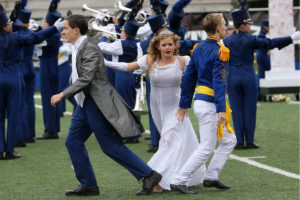 The two programs coexist in a school district and a city that is separated by less than five miles. A river, a lake, and a state border hem the two schools into an area of about 46 square miles, making it difficult for students of the two programs to avoid one another. “No matter how many people you add here, we’re still close to each other,” says John Pruitt, director of bands for Fort Mill High School. “Students know each other, they attend church together, they [go] to some social things together.”
The two programs coexist in a school district and a city that is separated by less than five miles. A river, a lake, and a state border hem the two schools into an area of about 46 square miles, making it difficult for students of the two programs to avoid one another. “No matter how many people you add here, we’re still close to each other,” says John Pruitt, director of bands for Fort Mill High School. “Students know each other, they attend church together, they [go] to some social things together.”
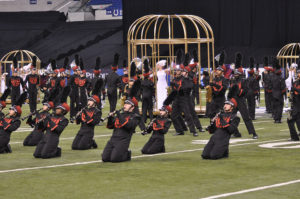 In and around Tulsa, Oklahoma, three high schools—Broken Arrow, Union, and Owasso—dominate their classes. Broken Arrow has 22 state championships, three BOA Grand National Championships, and appeared in the Tournament of Roses Parade several times. Union has 12 state championships and been a finalist at BOA. Owasso has finished in the top three of every state championship in which they have competed including a championship in 1996. Owasso has also been a participant in several well-known parades and was named the 2014 “Best Overall Band” in the St. Patrick’s Day Parade in Dublin, Ireland.
In and around Tulsa, Oklahoma, three high schools—Broken Arrow, Union, and Owasso—dominate their classes. Broken Arrow has 22 state championships, three BOA Grand National Championships, and appeared in the Tournament of Roses Parade several times. Union has 12 state championships and been a finalist at BOA. Owasso has finished in the top three of every state championship in which they have competed including a championship in 1996. Owasso has also been a participant in several well-known parades and was named the 2014 “Best Overall Band” in the St. Patrick’s Day Parade in Dublin, Ireland.
The strength of their programs started 30 years ago. “Both Union and Broken Arrow in the ’80s really got a healthy rivalry going,” says Chris Harris, Owasso’s current director of bands who also served as an assistant director at Broken Arrow and taught at Union. “Those schools are only 15 minutes apart driving time. In fact, some of the Union district has Broken Arrow addresses. So they are right there next to each other in south Tulsa.”
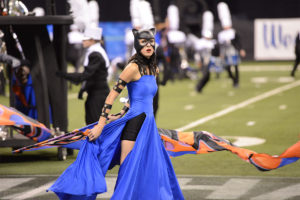 At Their Peaks
At Their Peaks
Being in proximity to one another, these organizations cross paths multiple times at competitions. Although the directors don’t always have time to share ideas and philosophies, they learn from observing.
Seeing the level of excellence at Broken Arrow and Union motivates Harris to step up his game and push his band to compete at a higher level. “They’re as good as it gets,” Harris says. “You’re just watching and kind of taking notes and noticing things that are really great and taking [those things] back to your program. We all do that.”
Charles Pisarra, director of bands and associate director of fine arts in the Union Public Schools, calls his relationship with the Tulsa band a very friendly synergy. “To me it’s very clear that having ambitious neighbors does nothing but make our team work harder,” he says. “Success breeds success.”
While there’s a mutual respect among all the local programs in Tulsa, the camaraderie between Owasso and Union is particularly strong. Harris was Pisarra’s percussion director in the mid-’90s when he was a student at Union, and they enjoy a great relationship to this day. “Union and Owasso have a long history of attending each other’s local marching band competitions, which has been a wonderful community connection for our students and patrons,” Pisarra says.
Martin Dickey, who is the current band director at Nation Ford and who directed at Fort Mill until Nation Ford opened, says there is no downside to having two quality band programs in the same town. “It’s beneficial to both of us,” he says.
Since Nation Ford opened, it has competed against Fort Mill a few times at the state level, but over the years, both programs have moved in and out of classes, so they don’t compete head-to-head every year. Originally a single booster club supported both programs. Since Nation Ford was fledgling in 2008, rather than creating its own parent association, the Fort Mill band boosters took Nation Ford under its wing. As the two programs forged their own identities, they separated into two booster groups.
Ayala’s percussion ensemble would not be as strong today, says Jackson, if not for the success of Chino Hills’s percussion ensemble. The programs push each other to perform at their peaks, and the directors use this mutual excellence to motivate their students. “I’ll say, ‘This year Chino Hills is going to come out, and they are going to be incredible. What do we need to do to be just as strong as them?’” Jackson says.
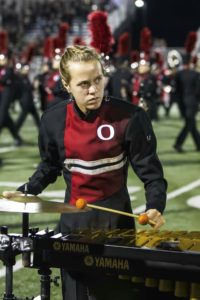 Not a Rivalry
Not a Rivalry
It’s difficult to talk about these highly competitive bands and their relationships to one another without using the word rivalry. But the directors of these top-tier programs shy away from that word, insisting that it does not belong in marching band vernacular.
Instead, each band strives for its personal best. “Everybody wants to go to a competition and get the highest score,” Harris says. “But there’s a human element. You have humans giving the scores, and you never know how it’s going to turn out. … We preach that we can only control what we do, and we want to do everything we can to be as good as we can be on performance day and give ourselves a shot at that top award. And if we don’t, at the very least, we gained excellence along the way.”
Throughout competition and as each season passes, the bands stay humble. “The Fort Mill Band doesn’t go out and brag about all the things they do,” Dickey says. “We don’t go out and brag about all the things we do [at Nation Ford].”
High school students are impressionable and will reflect the leadership that the adults around them model. If their directors preach rivalry, the students will view their relationship with other bands as a rivalry. “If we go hardcore into, ‘We’re going to beat Broken Arrow,’ then that’s just bad teaching,” Harris says. “That’s not the main goal. The goal is to entertain the crowd and be as good as we can be.”
While athletic coaches might use the word rivalry to motivate their athletes, music educators feel a more unified objective. “Good music educators understand that we are all in it together,” Dickey says. “You’re taking a creative outlet and putting it into a competitive event, and you’re not going to get the same result week after week.”
The music programs that “get it” know there’s no place for rivalries in marching band, says Pruitt from Fort Mill. Call it collaboration or cooperation, whatever you want. “But as soon as you say rivalry, top-tier groups are not interested,” he says.
On most Saturdays Fort Mill and Nation Ford march in separate competitions, and more often than not, they both return home as champions. On these weekends, the community celebrates both bands’ collective achievements. “It’s great when a community celebrates achievement wherever it is,” Pruitt says.
Staying Grounded
Top-tier programs reach the highest echelon of their classes for several reasons, not the least of which is parental support. Deep down inside, parents want their kids to earn a superior rating. “Sometimes you have a really close competition,” Harris says. “One group is a little stronger in one area, and the other group is a little stronger in another area, and it comes out to be just a few tenths of a point. And people are going to discuss [and ask], ‘Why did the judges do that?’”
To keep his students and their parents grounded, Dickey addresses both groups at band and booster meetings, making it perfectly clear that he will not tolerate negative comments about the competition on the field or in the stands.
Dickey says that his students can miss notes and march in the wrong direction all day long, and he’ll take it in stride. But when they or the parents criticize another band, he comes down hard on them. “It’s my job as the director of bands at Nation Ford High School to sit the parents down and say, ‘That’s not what we’re about,’” Dickey says.
The cities of Chino Hills, Fort Mill, and Tulsa don’t have exclusive rights to incredible band programs. Atlanta, Houston, Austin, San Antonio, and Indianapolis all produce band programs that can compete with any others. The level of excellence in these and many other cities starts locally and grows outward to encompass a wider area. Before long more and more bands from a region are competing at BOA. “You see a great band at a football game and say, ‘Holy cow, what are they doing?’” says Harris. “And then you’ll watch for them at a contest. We really do push and feed off of each other.”
Photo of Chino Hills courtesy of Ken Martinson/Marching.com.
Photo of Alaya courtesy of Vista Sight-n-Sound Productions.
Photo of Nation Ford courtesy of Mark Keenan.
Photo of Fort Mill courtesy of Josh Herbert.
Photo of Union courtesy of Ken Martinson/Marching.com.
Photo of Broken Arrow courtesy of Ken Martinson/Marching.com.
Photo of Owasso courtesy of Chris Harris.
Editor’s Note: The print edition of this article incorrectly identified Broken Arrow as a two-time BOA Grand Nationals Champion. They have won three times. Halftime Magazine regrets the error.


